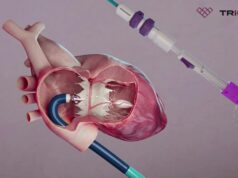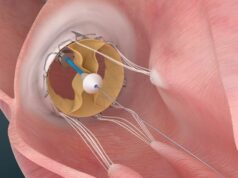
Transcatheter tricuspid valve intervention is associated with similar outcomes in both women and men, research published in the European Heart Journal indicates. Investigators also concluded that patients undergoing transcatheter therapy benefited from increased one-year survival compared to those receiving solely medical therapy, regardless of their sex.
Authored by Andrea Scotti, Augustin Coisne (both Montefiore Health System, New York, USA) and colleagues, the research sought to offer clarity on whether sex has an impact on characteristics and outcomes in patients with significant tricuspid regurgitation (TR) undergoing transcatheter tricuspid valve intervention.
“In our study, we showed that after transcatheter tricuspid valve intervention, clinical outcomes are similar in both women and men, with one-year survival rates of 81% and 78% respectively,” Scotti, Coisne et al write in their European Heart Journal paper. “Similarly, the survival benefit of transcatheter tricuspid valve intervention over medical therapy was significant irrespective of sex.”
Using the TriValve registry—an international, multicentre, retrospective, multidevice registry evaluating tricuspid valve intervention—the researchers assessed data from 556 patients who underwent transcatheter tricuspid valve intervention at 24 centres between 2016–2021. The patients undergoing transcatheter therapy were compared to a control cohort of 2,072 medically managed patients with severe or greater TR, diagnosed at the Montefiore–Einstein Center for Heart and Vascular Care during 2015–2018.
The investigators report that after transcatheter therapy, there was no difference between women and men in one-year freedom from all-cause mortality (p=0.56), nor in heart failure hospitalisation (p=0.36), New York Heart Association (NYHA) Functional Classes II and IV (p=0.17), and TR severity >2+ at last follow-up. Multivariable Cox-regression weighted by inverse probability of treatment weighting (IPTW) showed improved one-year survival after transcatheter compared with medical therapy alone in both women (adjusted hazard ratio [HR] 0.45, 95% confidence interval [CI] 0.23–0.83) and men (adjusted HR 0.42, 95% CI 0.18–0.89, p=0.03).

Discussing the findings, the authors highlight the fact that the baseline characteristics between women and men were not markedly different. “This may explain the discrepancies with surgical series, where women were at much higher risk compared with the male candidates,” the study team writes, adding that this stresses the importance of timely referral and management of tricuspid valve disease.
And, though the study authors note that theirs is the “most comprehensive” information on sex-related characteristics and outcomes on patients undergoing transcatheter tricuspid valve intervention to date, the research is limited by the fact that it is non-randomised, with no centralised echocardiographic core-lab or clinical adjudication committee.
“Longer term follow-up is required to determine if the observed outcomes with no differences between women and men are maintained or whether any new interactions may become apparent over time,” the researchers add.










